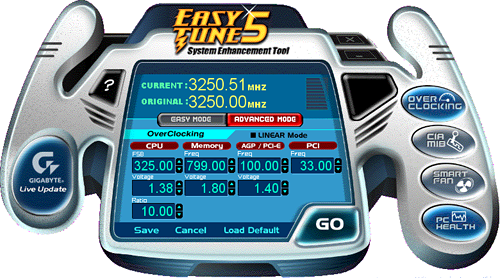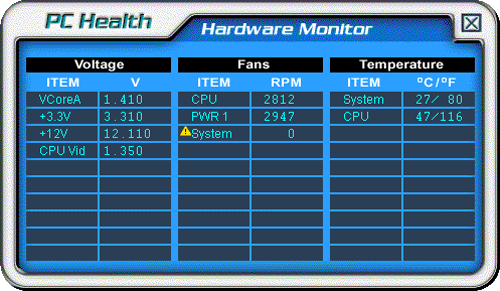Gigabyte GA-N680SLI-DQ6: Quad to the Extreme
by Gary Key on February 24, 2007 1:30 AM EST- Posted in
- Motherboards
Basic Features
Gigabyte follows a trend they started in the GA-P965-DQ6 series of boards by offering a significant level of BIOS options for tweaking the board, with emphasis placed on the available memory and voltage settings. In order to reach the majority of these settings you must utilize the archaic Ctrl-F1 keyboard sequence. We figure Gigabyte is still utilizing this keyboard shortcut as they must have paid rights to it, or maybe they are hoping to license it to Apple when they release an iCtrlU device. Whatever the reason, we hope Gigabyte will discontinue its use shortly.
For those who have been using Intel based boards exclusively, Gigabyte displays the FSB speeds in the typical Intel lingo of 100~650MHz instead of the NVIDIA heritage speak of 400~2600 QDR. Our one drawback with the BIOS is the voltages are listed in +{x}V values, which can be confusing if you do not know what the base voltages are for the item selected. We generally found the board would do a very good job of setting the various voltages when Auto was selected until we wanted to go over a 30% overclock. We would then have to chose Manual and adjust the voltages, at times having to do several reboots to lock in the right settings when overclocking. Considering our previous experiences with other 680i boards and knowing what voltage settings generally worked when overclocking, such as 1.45V for FSB, this additional time spent going through a test trial was somewhat frustrating.
The board is fully featured and looks to be hunting bear when it comes to the option check off list. We believe the majority of additional features like the two extra LAN ports and four additional SATA ports would make this an ideal board for home/multimedia/office/gaming server. It would also work well as the center piece for a gaming system where storage, expansion slots, and networking are a priority over pure overclocking performance. The Realtek ALC-888DD offers full Dolby Digital Live and DTS connect support and Gigabyte tossed in IEEE-1394 support as well. With the included external cables you also have the choice of up to four e-SATA ports depending upon your drive configuration.


Gigabyte also includes a full suite of utilities for the board: EasyTune5, Download Center, Xpress Install, @BIOS, and Xpress BIOS Rescue. We found the @BIOS utility to be very handy for downloading and then updating the BIOS while in Windows. For those who are squeamish about updating their BIOS within Windows, Gigabyte has their Q-Flash utility built into the BIOS that allows updating from a floppy drive. Now we just need the ability to update from a USB flash memory drive instead.
EasyTune5 is probably one of the most useful utilities in the Gigabyte arsenal and allows for control of the FSB and certain voltages within Windows. We found the utility worked well for squeezing out those last few FSB increases, but we still found ourselves tweaking the BIOS the majority of the time. The PC Health monitor provided basic readings of the system temperatures along with voltages. The board offers limited support for the NVIDIA nTune utility that limited changes to certain memory settings and FSB rates only.
| GIGABYTE GA-N680SLI-DQ6 | |
| Market Segment: | High End Enthusiast - $279.99 |
| CPU Interface: | Socket T (Socket 775) |
| CPU Support: | LGA775-based Pentium 4, Celeron D, Pentium D, Pentium EE, Core 2 Duo, Core 2 Extreme |
| Chipset: | NVIDIA 680i SPP (C55XE) + 680i MCP (MCP55PXE) |
| Bus Speeds: | Auto, 100 to 650 in 1MHz increments |
| Memory Ratios: | Auto, Sync, 1:1, 5:4, 3:2 |
| Memory Speed: | 400MHz~1400MHz in various increments |
| PCIe Speeds: | 100MHz~150MHz in 1MHz Increments |
| Core Voltage: | Auto, 0.68750V to 2.375V in 0.00625V increments |
| FSB Options: | Auto, Linked, Unlinked |
| CPU Clock Multiplier: | Auto, 6x-11x in 1X increments - Core 2 Duo, downwards unlocked Core 2 Extreme 6x-16X |
| DRAM Voltage: | Auto, +025VV ~ +.775V in .025V increments |
| DRAM Timing Control: | Optimal, Expert - 10 DRAM Timing Options |
| NB Voltage: | Auto, +.05V ~ +.20V in .05V increments |
| SB Voltage: | Auto, +.05V ~ +.35V in .05V increments |
| FSB Voltage: | Auto, +.05V ~ +.35V in .05V increments |
| HT Link Voltage: | Auto, +.05V ~ +.35V in .05V increments |
| Memory Slots: | Four 240-pin DDR2 DIMM Slots Dual-Channel Configuration Regular Unbuffered Memory to 8GB Total |
| Expansion Slots: | 2 - PCIe X16 (2-x16 electrical for SLI or Multi-GPU) 1 - PCIe X16 (1-x8 electrical) 1 - PCIe x1 3 - PCI Slot 2.2 |
| Onboard SATA/RAID: | 6 SATA 3Gbps Ports - 680i MCP (RAID 0, 1, 0+1, 5, JBOD) 4 SATA 3Gbps Ports - JMicron JMB363 (RAID 0, 1, 0+1, JBOD) |
| Onboard IDE: | 1 ATA133/100/66 Port (2 drives) - 680i MCP |
| Onboard USB 2.0/IEEE-1394: | 10 USB 2.0 Ports - 4 I/O Panel - 6 via Headers 3 Firewire 400 Ports by TI TSB43AB23 - 1 I/O Panel, 2 via Header |
| Onboard LAN: | Marvell Gigabit Ethernet - PCI Express - 88E1116 PHY - 2 ports via 680i MCP Marvell Gigabit Ethernet - PCI Express - 88E8056 - 1 port Marvell Gigabit Ethernet - PCI Express - 88E8052 - 1 port |
| Onboard Audio: | Realtek ALC888DD - 8-channel HD audio codec |
| Power Connectors: | ATX 24-pin, 8-pin EATX 12V, 4-pin 12V Molex |
| I/O Panel: | 1 x PS/2 Keyboard 1 x PS/2 Mouse 1 x Serial Port 1 x S/PDIF Optical - Out 1 x IEEE 1394a 1 x Audio Panel 4 x RJ45 4 x USB 2.0/1.1 |
| BIOS Revision: | Award F3B |
| Board Revision: | v1.0 |
Gigabyte follows a trend they started in the GA-P965-DQ6 series of boards by offering a significant level of BIOS options for tweaking the board, with emphasis placed on the available memory and voltage settings. In order to reach the majority of these settings you must utilize the archaic Ctrl-F1 keyboard sequence. We figure Gigabyte is still utilizing this keyboard shortcut as they must have paid rights to it, or maybe they are hoping to license it to Apple when they release an iCtrlU device. Whatever the reason, we hope Gigabyte will discontinue its use shortly.
For those who have been using Intel based boards exclusively, Gigabyte displays the FSB speeds in the typical Intel lingo of 100~650MHz instead of the NVIDIA heritage speak of 400~2600 QDR. Our one drawback with the BIOS is the voltages are listed in +{x}V values, which can be confusing if you do not know what the base voltages are for the item selected. We generally found the board would do a very good job of setting the various voltages when Auto was selected until we wanted to go over a 30% overclock. We would then have to chose Manual and adjust the voltages, at times having to do several reboots to lock in the right settings when overclocking. Considering our previous experiences with other 680i boards and knowing what voltage settings generally worked when overclocking, such as 1.45V for FSB, this additional time spent going through a test trial was somewhat frustrating.
The board is fully featured and looks to be hunting bear when it comes to the option check off list. We believe the majority of additional features like the two extra LAN ports and four additional SATA ports would make this an ideal board for home/multimedia/office/gaming server. It would also work well as the center piece for a gaming system where storage, expansion slots, and networking are a priority over pure overclocking performance. The Realtek ALC-888DD offers full Dolby Digital Live and DTS connect support and Gigabyte tossed in IEEE-1394 support as well. With the included external cables you also have the choice of up to four e-SATA ports depending upon your drive configuration.


Gigabyte also includes a full suite of utilities for the board: EasyTune5, Download Center, Xpress Install, @BIOS, and Xpress BIOS Rescue. We found the @BIOS utility to be very handy for downloading and then updating the BIOS while in Windows. For those who are squeamish about updating their BIOS within Windows, Gigabyte has their Q-Flash utility built into the BIOS that allows updating from a floppy drive. Now we just need the ability to update from a USB flash memory drive instead.
EasyTune5 is probably one of the most useful utilities in the Gigabyte arsenal and allows for control of the FSB and certain voltages within Windows. We found the utility worked well for squeezing out those last few FSB increases, but we still found ourselves tweaking the BIOS the majority of the time. The PC Health monitor provided basic readings of the system temperatures along with voltages. The board offers limited support for the NVIDIA nTune utility that limited changes to certain memory settings and FSB rates only.










12 Comments
View All Comments
tuteja1986 - Sunday, February 25, 2007 - link
ahh... english."Well Gigabyte GA-N680SL-DQ6 isn't even selling it. It will sale next month. They still have time to fix the bugs. Anyways i say buying the striker at launch for $400 was a foolish thing to do since it was buggy as hell. It took for them months to fix the problem."
correct :
Gigabyte GA-N680SL-DQ6 isn't even coming out untill next month so i think gigabyte has some time to address the issue and release an bios update for it.
tuteja1986 - Saturday, February 24, 2007 - link
If this board sell for $250 then i would buy it without a second thought. Much cheaper than Striker ; )